Power electronic handbook
Подождите немного. Документ загружается.

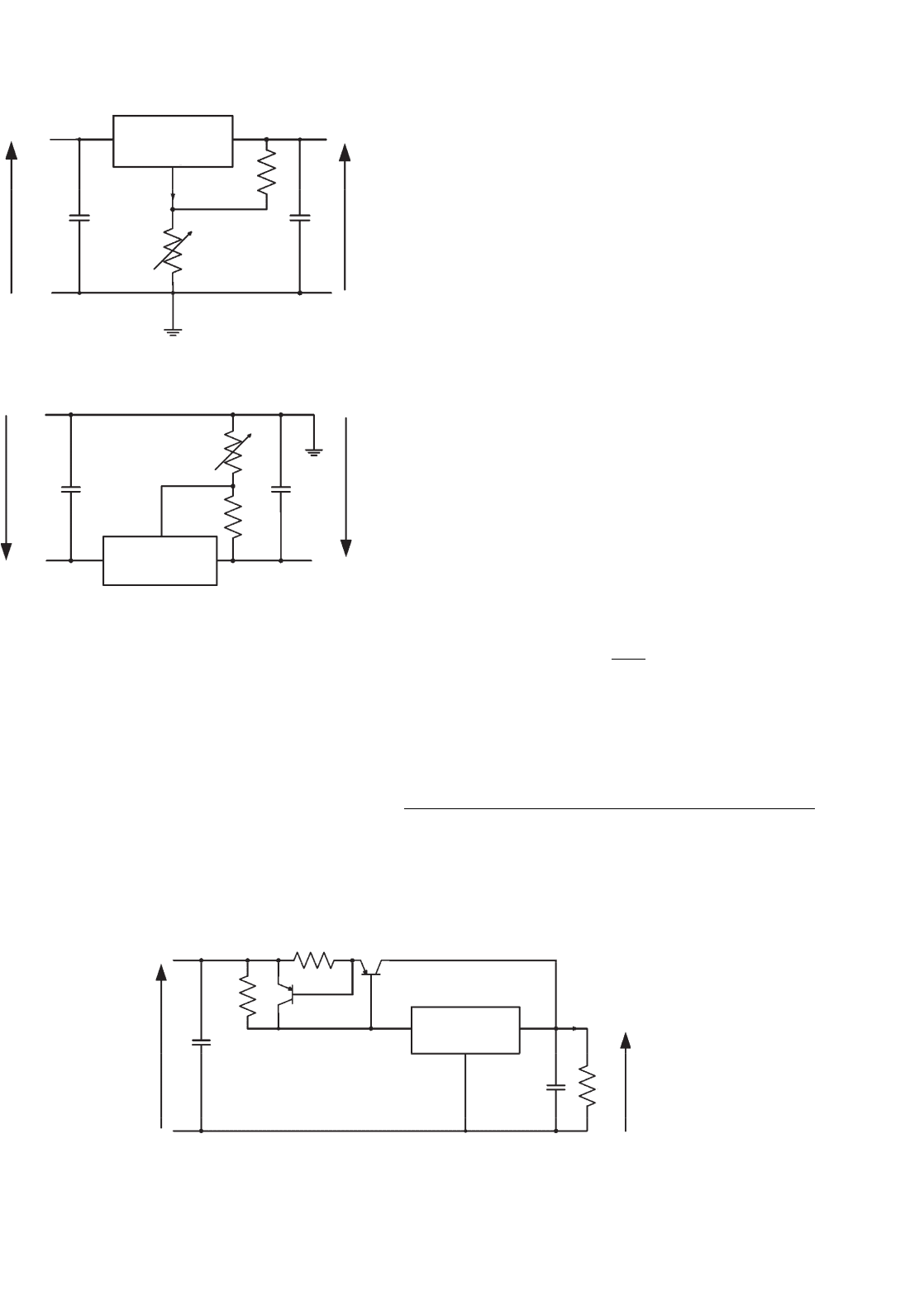
602 Y. M. Lai
V
o
V
I
C
2
R
1
C
1
R
2
I
adj
V
REF
=1.25 V
LM317
In
Out
Adj
+
+
+
−
FIGURE 23.17 The LM317 adjustable positive voltage regulator.
V
o
V
I
C
2
R
1
C
1
R
2
LM337
In
Out
Adj
+
+
FIGURE 23.18 The LM337 adjustable negative voltage regulator.
where I
adj
is a constant current into the adjustment terminal
and has a value of approximately 50 µA for the LM317. As can
be seen from Eq. (23.13), with fixed R
1
, V
o
can be adjusted by
varying R
2
.
The LM337 adjustable voltage regulator is similar to the
LM317 except that it provides negative regulated voltages
instead of positive ones. Figure 23.18 shows the standard con-
figuration of a LM337 voltage regulator. The output voltage
can be adjusted from –1.2 to –37 V, depending on the external
resistors R
1
and R
2
.
V
o
V
I
R
L
I
L
C
2
R
2
R
1
C
1
Q
1
Q
2
78XX
In
Out
Gnd
+
+
FIGURE 23.19 A 78XX series regulator with an external pass transistor.
23.4.3 Applications of Linear IC
Voltage Regulators
Most IC regulators are limited to an output current of 2.5 A.
If the output current of an IC regulator exceeds its maximum
allowable limit, its internal pass transistor will dissipate an
amount of energy more than it can tolerate. As a result, the
regulator will be shutdown.
For applications that require more than the maximum
allowable current limit of a regulator, an external pass transis-
tor can be used to increase the output current. Figure 23.19
illustrates such a configuration. This circuit has the capability
of producing higher current to the load, but still preserving
the thermal shutdown and short-circuit protection of the IC
regulator.
A constant current-limiting scheme, as discussed in
Section 23.2.2, is implemented by using the transistor Q
2
and
the resistor R
2
to protect the external pass transistor Q
1
from
excessive current under current-overload or short-circuit con-
ditions. The value of the external current-sensing resistor R
1
determines the value of current at which Q
1
begins to conduct.
As long as the current is less than the value set by R
1
, the tran-
sistor Q
1
is off, and the regulator operates normally as shown
in Fig. 23.15. But when the load current I
L
starts to increase,
the voltage across R
1
also increases. This turns on the external
transistor Q
1
and conducts the excess current. The value of R
1
is determined by
R
1
=
0.7 V
I
max
(23.14)
where I
max
is the maximum current that the voltage regulator
can handle internally.
23.5 Switching Regulators
The linear series and shunt regulators have control transistors
that are operating in their linear active regions. Regulation
is achieved by varying the conduction of the transistors to

23 Power Supplies 603
maintain the output voltage at a desirable level. The switch-
ing regulator is different in that the control transistor operates
as a switch, either in cutoff or saturation region. Regulation
is achieved by adjusting the on-time of the control transis-
tor. In this mode of operation, the control transistor does not
dissipate as much power as that in the linear types. Therefore,
switching voltage regulators have a much higher efficiency and
can provide greater load currents at low voltage than linear
regulators.
Unlike their linear counterparts, switching regulators can
be implemented by many different topologies such as for-
ward and flyback. In order to select an appropriate topology
for an application, it is necessary to understand the merits
and drawbacks of each topology and the requirements of the
application. Basically, most topologies can work for various
applications. Therefore, we have to determine from the fac-
tors such as cost, performances, and application that make
one topology more desirable than the others. However, no
matter which topology we decide to use, the basic building
blocks of an off-the-line switching power supply are the same,
as depicted in Fig. 23.1.
In this section, some popular switching regulator topologies,
namely flyback, forward, half-bridge, and full-bridge topolo-
gies, are presented. Their basic operation is described, and the
critical waveforms are shown and explained. The merits, draw-
backs, and application areas of each topology are discussed.
Finally, the control circuitry and PWM of the regulators will
also be discussed.
23.5.1 Single-ended Isolated Flyback Regulators
An isolated flyback regulator consists of four main circuit ele-
ments: a power switch, a rectifier diode, a transformer, and a
filter capacitor. The power switch, which can be either a power
transistor or a MOSFET, is used to control the flow of energy in
the circuit. A transformer is placed between the input source
and the power switch to provide DC isolation between the
input and the output circuits. In addition to being an energy
storage element, the transformer also performs a stepping up
or down function for the regulator. The rectifier diode and
filter capacitor form an energy transfer mechanism to supply
energy to maintain the output voltage of the supply. Note that
there are two distinct operating modes for flyback regulators:
continuous and discontinuous. However, both modes have an
identical circuit. It is only the transformer magnetizing cur-
rent that determines the operating mode of the regulator.
Figure 23.20(a) shows a simplified isolated flyback regula-
tor. The associated steady-state waveforms, resulting from a
discontinuous-mode operation, is shown in Fig. 23.20(b). As
shown in the figure, the voltage regulation of the regulator is
achieved by a control circuit, which controls the conduction
period or duty cycle of the switch, to keep the output voltage
at a constant level. For clarity, the schematics and operation
of the control circuit will be discussed in a separate section.
23.5.1.1 Discontinuous-mode Flyback Regulators
Under steady-state conditions, the operation of the regula-
tor can be explained as follows. When the power switch Q
1
is on, the primary current I
p
starts to build up and stores
energy in the primary winding. Because of the opposite-
polarity arrangement between the input and output windings
of the transformer, the rectifier diode D
R
is reverse-biased.
In this period of time, there is no energy transferred from the
input to the load R
L
. The output voltage is supported by the
load current I
L
, which is supplied from the output filter capac-
itor C
F
. When Q
1
is turned off, the polarity of the windings
reverses as a result of the fact that I
p
cannot change instanta-
neously. This causes D
R
to turn on. Now D
R
is conducting,
charging the output capacitor C
F
and delivering current to R
L
.
This charging action ends at the point where all the magnetic
energy stored in the secondary winding during the first half-
cycle is emptied. At this point, D
R
will cease to conduct and
R
L
absorbs energy just from C
F
until Q
1
is switched on again.
During the Q
1
on-time, the voltage across the primary
winding of the transformer is V
i
. The current in the primary
winding I
p
increases linearly and is given by
I
p
=
V
i
t
on
L
p
(23.15)
where L
p
is the primary magnetizing inductance. At the end
of the on-time, the primary current reaches a value equal to
I
p(pk)
and is given by
I
p(pk)
=
V
i
DT
L
p
(23.16)
where D is the duty cycle and T is the switching period. Now
when Q
1
turns off, the magnetizing current in the transformer
forces the reversal of polarities on the windings. At the instant
of turn off, the amplitude of the secondary current I
s(pk)
is
I
s(pk)
=
N
p
N
s
I
p(pk)
(23.17)
This current decreases linearly at the rate of
dI
s
dt
=
V
o
L
s
(23.18)
where L
s
is the secondary magnetizing inductance.
In the discontinuous-mode operation, I
s(pk)
will decrease
linearly to zero before the start of the next cycle. Since the
energy transfer from the source to the output takes place only
in the first half cycle, the power drawn from V
i
is then
P
in
=
L
p
I
2
p
2T
(23.19)
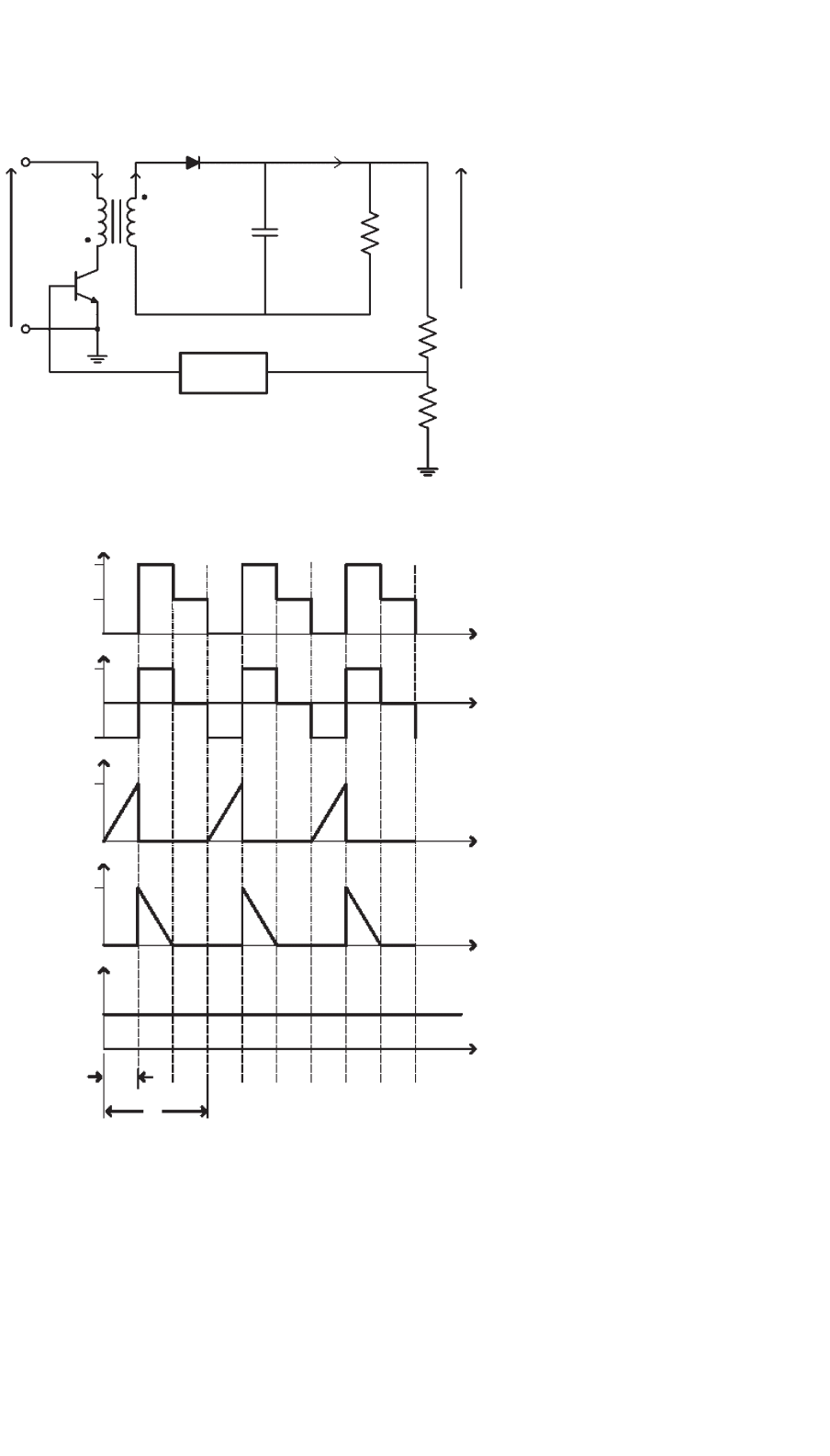
604 Y. M. Lai
(a)
(b)
C
F
V
i
R
L
I
L
R
2
V
o
R
1
D
R
V
Q1
V
Q1
V
i
+(N
p
/N
s
)V
o
(N
p
/N
s
)I
p(pk)
I
p(pk)
−(N
s
/N
p
)V
o
V
i
V
o
I
p
V
S
V
o
I
S
N
S
V
S
I
S
I
p
N
p
Q
1
Control
0
0
0
0
0
DT
T
t
t
t
t
t
+
+
−
−
FIGURE 23.20 A simplified isolated flyback regulator: (a) circuit and (b) the associated waveforms.
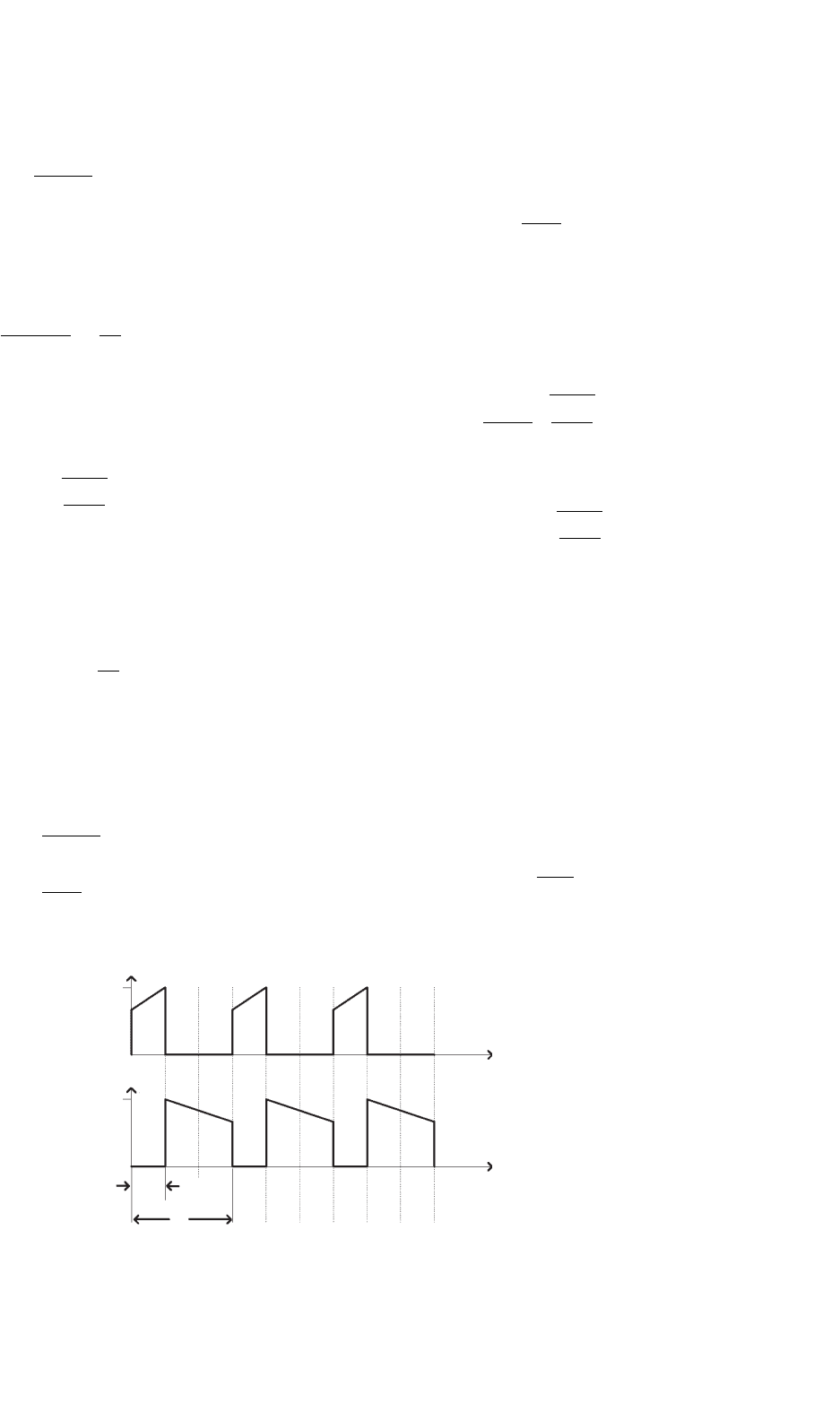
23 Power Supplies 605
Substituting Eq. (23.15) into Eq. (23.19), we have
P
in
=
(
V
i
t
on
)
2
2TL
p
(23.20)
The output power P
o
may be written as
P
o
= ηP
in
=
η
(
V
i
t
on
)
2
2TL
p
=
V
2
o
R
L
(23.21)
where η is the efficiency of the regulator. Then, from
Eq. (23.21), the output voltage V
o
is related to the input voltage
V
i
by
V
o
= V
i
D
ηR
L
T
2L
p
(23.22)
Since the collector voltage V
Q1
of Q
1
is maximum when
V
i
is maximum, the maximum collector voltage V
Q1(max)
,as
shown in the Fig. 23.20(b), is given by
V
Q1(max)
= V
i(max)
+
N
p
N
s
V
o
(23.23)
The primary peak current I
p(pk)
can be found in terms of P
o
by combining Eq. (23.16) and Eq. (23.21) and then eliminating
L
p
as
I
p(pk)
=
2V
2
o
ηV
i
DR
L
=
2P
o
ηV
i
D
(23.24)
I
p
I
S
I
p(pk)
(N
p
/N
s
)I
p(pk)
t
t
0
0
DT
T
FIGURE 23.21 The primary and secondary winding currents of a flyback regulator operated in the continuous-mode.
The maximum collector current I
C( max)
of the power switch
Q
1
at turn on is
I
C(max)
= I
p(pk)
=
2P
o
ηV
i
D
(23.25)
As can be seen from Eq. (23.21), V
o
will be maintained con-
stant by keeping the product V
i
t
on
constant. Since maximum
on-time t
on(max)
occurs at minimum supply voltage V
i(min)
,
the maximum allowable duty cycle for the discontinuous-
mode can be found from Eq. (23.22) as
D
max
=
V
o
V
i(min)
2L
p
ηR
L
T
(23.26)
and V
o
at D
max
is then
V
o
= V
i(min)
D
max
ηR
L
T
2L
p
(23.27)
23.5.1.2 Continuous-mode Flyback Regulators
In the continuous-mode operation, the power switch is turned
on before all the magnetic energy stored in the secondary
winding empties itself. The primary and secondary current
waveforms have a characteristic appearance as shown in
Fig. 23.21. This mode produces a higher power capability
without increasing the peak currents. During the on-time, the
primary current I
p
rises linearly from its initial value I
p
(0) and
is given by
I
p
= I
p
(0) +
V
i
t
on
L
p
(23.28)

606 Y. M. Lai
At the end of the on-time, the primary current reaches a
value equal to I
p(pk)
and is given by
I
p(pk)
= I
p
(0) +
V
i
DT
L
p
(23.29)
In general, I
p
(0) V
i
DT
L
p
; thus, Eq. (23.29) can be
written as
I
p(pk)
≈ I
p
(0) (23.30)
The secondary current I
s
at the instant of turn off is
given by
I
s(pk)
=
N
p
N
s
I
p(pk)
=
N
p
N
s
I
p
(0) +
V
i
DT
L
p
≈
N
p
N
s
I
p
(0)
(23.31)
This current decreases linearly at the rate of
dI
s
dt
=
V
o
L
s
(23.32)
The output power P
o
is equal to V
o
times the time-average
of the secondary current pulses and is given by
P
o
= V
o
I
s
T − t
on
T
≈ V
o
I
s(pk)
T − t
on
T
(23.33)
or
I
s(pk)
=
P
o
V
o
(1 −t
on
/T)
(23.34)
For an efficiency of η, the input power P
in
is
P
in
=
P
o
η
= V
i
I
p
t
on
T
≈ V
i
I
p(pk)
t
on
T
(23.35)
or
I
p(pk)
=
P
o
ηV
i
(
t
on
/
T
)
(23.36)
Combining Eqs. (23.31), (23.34), and (23.36) and solving
for V
o
, we have
V
o
=
N
s
N
p
ηV
i
D
1 −D
(23.37)
The output voltage at D
max
is then
V
o
=
N
s
N
p
ηV
i(min)
D
max
1 −D
max
(23.38)
The maximum collector current I
C(max)
for the continuous-
mode is then given by
I
C( max)
= I
p(pk)
=
P
o
ηV
i
D
max
(23.39)
The maximum collector voltage of Q
1
is the same as that in
the discontinuous-mode and is given by
V
Q1(max)
= V
i(max)
+
N
p
N
s
V
o
(23.40)
The maximum allowable duty cycle for the continuous-
mode can be found from Eqs. (23.38) and is given by
D
max
=
1
1 +
N
s
N
p
ηV
i(min)
V
o
(23.41)
At the transition from the discontinuous-mode to
continuous-mode (or from continuous-mode to discontinuous-
mode), the relationships in Eqs. (23.27) and (23.38) must hold.
Thus, equating these two equations, we have
V
i(min)
D
max
ηR
L
T
2L
p
=
N
s
N
p
D
max
1 −D
max
ηV
i(min)
(23.42)
Solving this equation for L
p
to give the critical inductance
L
p(limit)
, at which the transition occurs, we have
L
p(limit)
=
1
2η
TR
L
(
1 −D
max
)
N
p
N
s
2
=
1
2η
T
V
2
o
P
o
(
1 −D
max
)
N
p
N
s
2
(23.43)
Replacing V
o
with Eq. (23.38) and solving for L
p(limit)
,we
have
L
p(limit)
=
1
2
ηT
D
2
max
V
2
i(min)
P
o
(23.44)
Then, for a given D
max
, input, and output quantities, the
inductance value L
p(limit)
in Eq. (23.44) determines the mode

23 Power Supplies 607
of operation for the regulator. If L
p
< L
p(limit)
, then the circuit
is operated in the discontinuous-mode. Otherwise, if L
P
>
L
p(limit)
, the circuit is operated in the continuous-mode.
In designing flyback regulators, regardless of their operating
modes, the power switch must be able to handle the peak
collector voltage at turn off and the peak collector currents at
turn on as shown in Eqs. (23.23), (23.25), (23.39), and (23.40).
The flyback transformer, because of its unidirectional use of
the B–H curve, has to be designed so that it will not be driven
into saturation. To avoid saturation, the transformer needs a
relatively large core with an air gap in it.
Although the continuous and discontinuous modes have an
identical circuit, their operating properties differ significantly.
As opposed to the discontinuous-mode, the continuous-mode
can provide higher power capability without increasing the
peak current I
p(pk)
. It means that, for the same output power,
the peak currents in the discontinuous-mode are much higher
than those operated in the continuous-mode. As a result, a
higher current rating and, therefore, a more expensive power
transistor is needed. Moreover, the higher secondary peak cur-
rents in the discontinuous-mode will have a larger transient
spike at the instant of turn off. However, despite all these
problems, the discontinuous-mode is still much more widely
used than its continuous-mode counterpart. There are two
main reasons. First, the inherently smaller magnetizing induc-
tance gives the discontinuous-mode a quicker response and a
lower transient output voltage spike to sudden changes in load
current or input voltage. Second, the continuous-mode has a
right-half-plane zero in its transfer function, which makes the
feedback control circuit more difficult to design.
The flyback configuration is mostly used in applications
with output power below 100 W. It is widely used for high
output voltages at relatively low power. The essential attrac-
tions of this configuration are its simplicity and low cost.
D
R1
D
R2
N
p
N
s
D
R3
Q
1
Q
2
Control
V
i
C
F
R
L
V
o
R
1
R
2
FIGURE 23.22 A double-ended flyback regulator.
Since no output filter inductor is required for the secondary,
there is a significant saving in cost and space, especially for
multiple output power supplies. Since there is no output fil-
ter inductor, the flyback exhibits high ripple currents in the
transformer and at the output. Thus, for higher power appli-
cations, the flyback becomes an unsuitable choice. In practice,
a small LC filter is added after the filter capacitor C
F
in order
to suppress high-frequency switching noise spikes.
As mentioned previously, the collector voltage of the power
transistor must be able to sustain a voltage as defined in
Eq. (23.23). In cases where the voltage is too high for the tran-
sistor to handle, the double-ended flyback regulator shown in
Fig. 23.22 may be used. The regulator uses two transistors that
are switched on or off simultaneously. The diodes D
R1
and
D
R2
are used to restrict the maximum collector voltage to V
i
.
Therefore, the transistors with a lower voltage rating can be
used in the circuit.
23.5.2 Single-ended Isolated Forward Regulators
Although the general appearance of an isolated forward regula-
tor resembles that of its flyback counterpart, their operations
are different. The key difference is that the dot on the sec-
ondary winding of the transformer is so arranged that the
output diode is forward-biased when the voltage across the
primary is positive, that is, when the transistor is on. Energy
is thus not stored in the primary inductance as it was for
the flyback. The transformer acts strictly as a transformer.
An inductive energy storage element is required at the output
for proper and efficient energy transfer.
Unlike the flyback, the forward regulator is very suitable for
working in the continuous-mode. In the discontinuous-mode,
the forward regulator is more difficult to control because of a

608 Y. M. Lai
double-pole at the output filter. Thus, it is not as much used as
the continuous-mode. In view of it, only the continuous-mode
will be discussed here.
Figure 23.23 shows a simplified isolated forward regulator
and the associated steady-state waveforms for the continuous-
mode operation. Again for clarity, the details of the control
circuit are omitted from the figure. Under steady-state condi-
tion, the operation of the regulator can be explained as follows.
When the power switch Q
1
turns on, the primary current I
p
starts to build up and stores energy in the primary winding.
Because of the same polarity arrangement of the primary and
secondary windings, this energy is forward-transferred to the
secondary and onto the L
1
C
F
filter and the load R
L
through the
rectifier diode D
R2
, which is forward-biased. When Q
1
turns
off, the polarity of the transformer winding voltage reverses.
This causes D
R2
, to turn off and D
R1
, and D
R3
, to turn on.
Now D
R3
, is conducting and delivering energy to R
L
through
the inductor L
1
. During this period, the diode D
R1
, and the
tertiary winding provide a path for the magnetizing current
returning to the input.
When the transistor Q
1
is turned on, the voltage across
the primary winding is V
i
. The secondary winding current
is reflected into the primary, and the reaction current I
p
,as
shown in Fig. 23.24, is given by
I
p
=
N
s
N
p
I
s
(23.45)
The magnetizing current in the primary has a magnitude of
I
mag
and is given by
I
mag
=
V
i
t
on
L
p
(23.46)
The total primary current I
p
is then
I
p
= I
p
+I
mag
=
N
s
N
p
I
s
+
V
i
t
on
L
p
(23.47)
The voltage developed across the secondary winding V
s
is
V
s
=
N
s
N
p
V
i
(23.48)
Neglecting diode voltage drops and losses, the voltage across
the output inductor is V
s
− V
o
. The current in L
1
increases
linearly at the rate of
I
L1
=
(V
s
−V
o
)t
on
L
1
(23.49)
At the end of the on-time, the total primary current reaches
a peak value equal to I
p(pk)
and is given by
I
p(pk)
= I
p
(0) +
V
i
DT
L
p
(23.50)
The output inductor current I
L1
is
I
L1(pk)
= I
L1
(0) +
(V
s
−V
o
)DT
L
1
(23.51)
At the instant of turn on, the amplitude of the secondary
current has a value of I
s(pk)
and is given by
I
s(pk)
=
N
p
N
s
I
p(pk)
=
N
p
N
s
I
p
(0) +
V
i
DT
L
p
(23.52)
During the off-time, the current I
L1
in the output inductor
is equal to the current I
DR3
in the rectifier diode D
R3
and both
decrease linearly at the rate of
dI
L1
dt
=
dI
DR3
dt
=
V
o
L
1
(23.53)
The output voltage V
o
can be found from the time integral
of the secondary winding voltage over a time equal to DT of
the switch Q
1
. Thus, we have
V
o
=
1
T
DT
0
N
s
N
p
V
i
dt
=
N
s
N
p
V
i
D
(23.54)
The maximum collector current I
C( max)
at turn on is equal
to I
p(pk)
and is given by
I
C(max)
= I
p(pk)
=
N
s
N
p
I
p
(0) +
V
i
DT
L
p
(23.55)
The maximum collector voltage V
Q1(max)
at turn-off is equal
to the maximum input voltage V
i(max)
plus the maximum
voltage V
r(max)
across the tertiary winding and is given by
V
Q1(max)
= V
i(max)
+V
r(max)
= V
i(max)
1 +
N
p
N
r
(23.56)
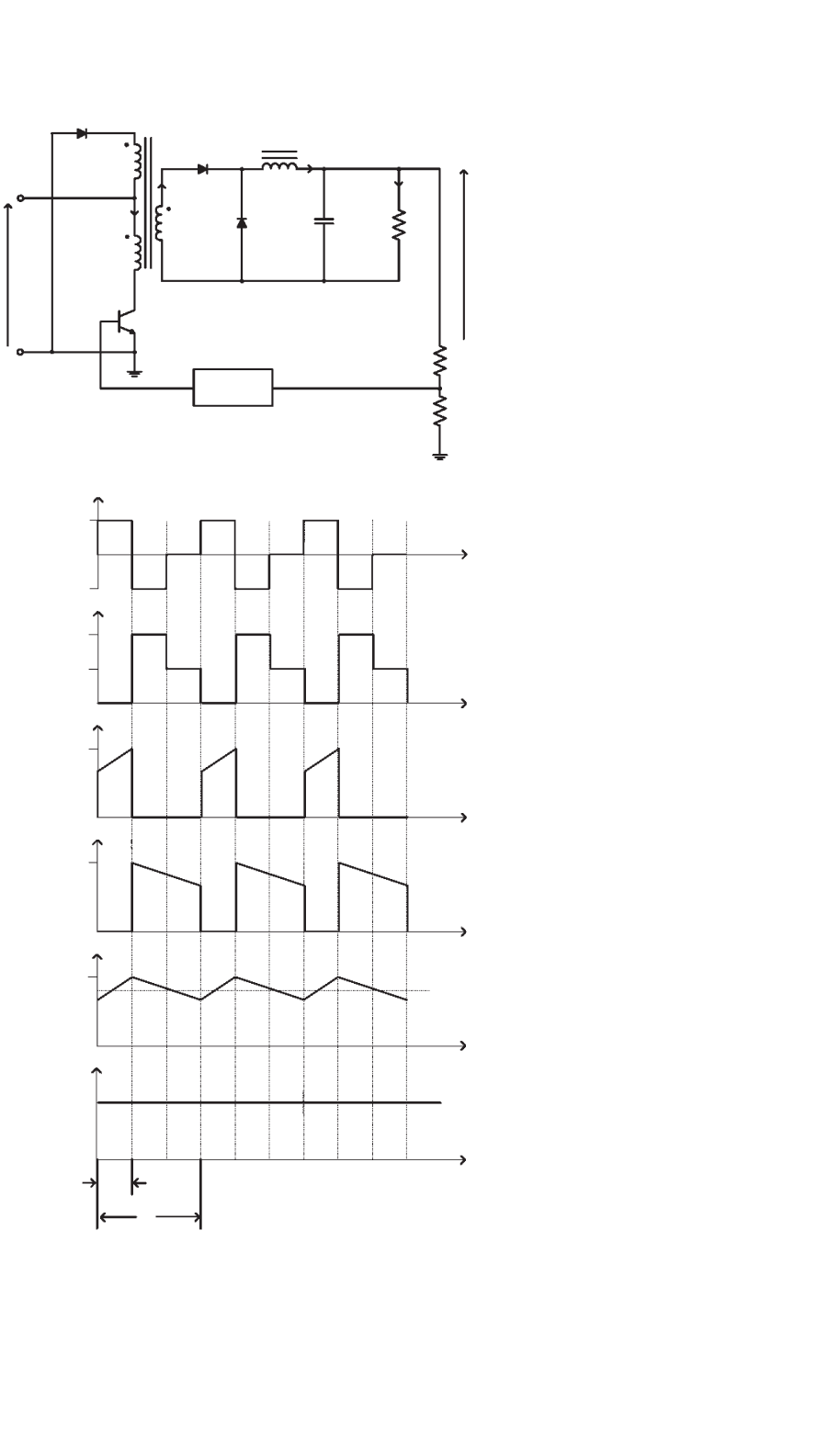
23 Power Supplies 609
(a)
(b)
C
F
V
I
V
r
N
r
R
L
I
L
I
L1
I
L
R
2
V
o
R
1
D
R2
D
R3
D
R1
V
Q1
V
p
V
Q1
V
i
−V
i
V
i
+(N
p
/N
s
)V
i
(N
p
/N
s
)I
p(pk)
′
(N
p
/N
s
)I
p(pk)
′
I
p(pk)
′
V
i
I
p
I
DR3
I
L1
I
L
V
o
N
s
V
s
I
s
I
p
N
p
Q
1
Control
0
0
0
0
0
0
DT
T
t
t
t
t
t
t
+
+
+
−
−
−
FIGURE 23.23 A simplified isolated forward regulator: (a) circuit and (b) the associated waveforms.
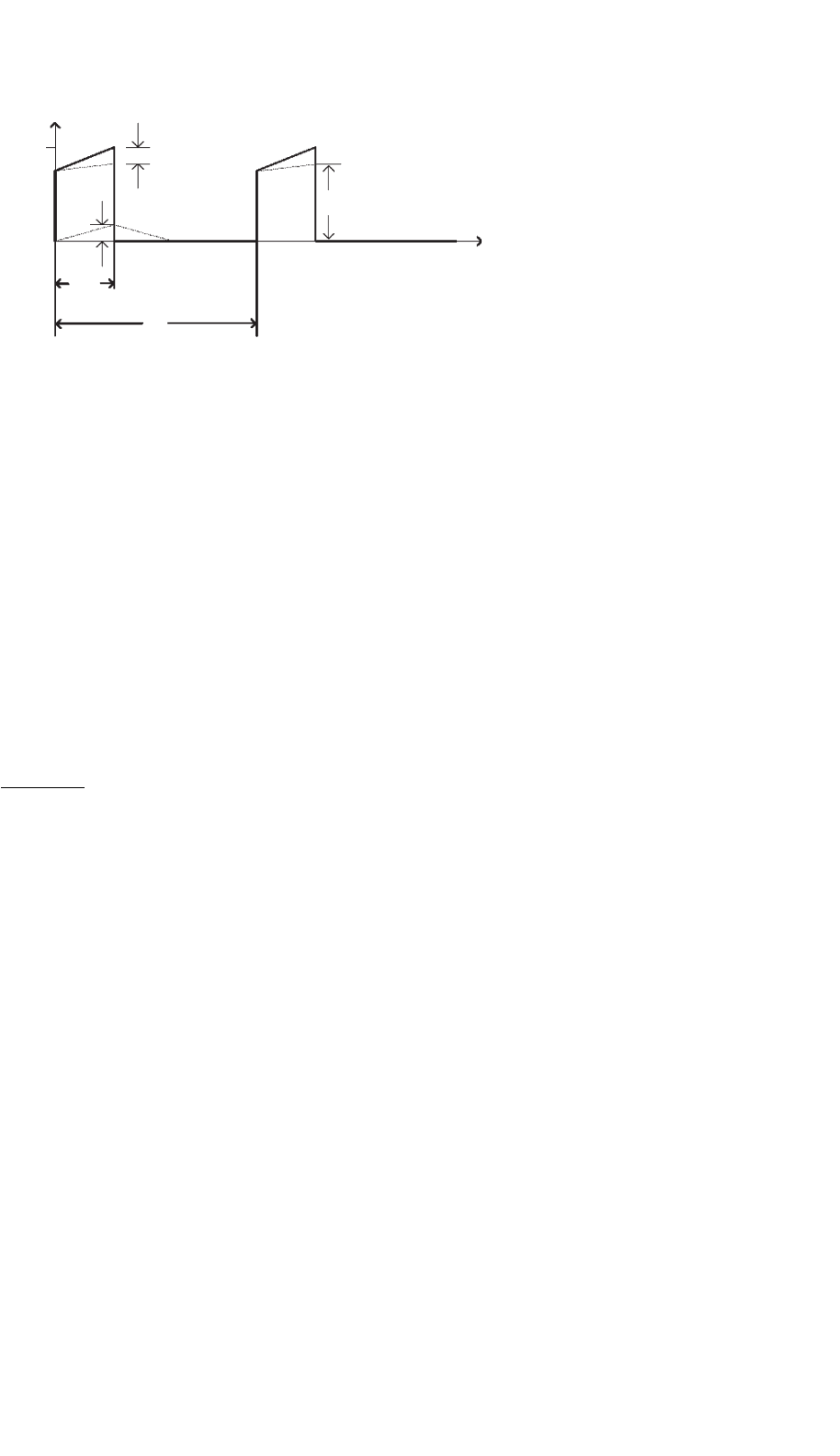
610 Y. M. Lai
I
p
t
I
mag
I
mag
I
p
I
p(pk)
′
DT
T
FIGURE 23.24 The current components in the primary winding.
The maximum duty cycle for the forward regulator oper-
ated in the continuous-mode can be determined by equating
the time integral of the input voltage when Q
1
is on and the
clamping voltage V
r
when Q
1
is off.
DT
0
V
i
dt =
T
DT
V
r
dt (23.57)
which leads to
V
i
DT = V
r
(1 −D)T (23.58)
Grouping the D terms in Eq. (23.58) and replacing V
r
/
V
i
with N
r
N
p
, we have
D
max
=
1
1 +N
r
N
p
(23.59)
Thus, the maximum duty cycle depends on the turn ratio
between the demagnetizing winding and the primary one.
In designing forward regulators, the duty cycle must be kept
below the maximum duty cycle D
max
to avoid saturating the
transformer. It should also be noted that the transformer mag-
netizing current must be reset to zero at the end of each cycle.
Failure to do so will drive the transformer into saturation,
which can cause damage to the transistor. There are many ways
of implementing the resetting function. In the circuit shown
in Fig. 23.23(a), a tertiary winding is added to the transformer
so that the magnetizing current will return to the input source
V
i
when the transistor turns off. The primary current always
starts at the same value under the steady state condition.
Unlike flyback regulators, forward regulators require a min-
imum load at the output. Otherwise, excess output voltage will
be produced. One commonly used method to avoid this situa-
tion is to attach a small load resistance at the output terminals.
Of course, with such an arrangement, a certain amount of
power will be lost in the resistor.
Because forward regulators do not store energy in their
transformers, for the same output power level the transformer
can be made smaller than for the flyback type. The output cur-
rent is reasonably constant owing to the action of the output
inductor and the flywheel diode; as a result, the output filter
capacitor can be made smaller and its ripple current rating can
be much lower than that required for the flybacks.
The forward regulator is widely used with output power
below 200 W, though it can be easily constructed with a much
higher output power. The limitation comes from the capabil-
ity of the power transistor to handle the voltage and current
stresses if the output power were to increase. In this case, a con-
figuration with more than one transistor can be used to share
the burden. Figure 23.25 shows a double-ended forward reg-
ulator. Like the double-ended flyback counterpart, the circuit
uses two transistors which are switched on and off simultane-
ously. The diodes are used to restrict the maximum collector
voltage to V
i
. Therefore, the transistors with low voltage rating
can be used in the circuit.
23.5.3 Half-bridge Regulators
The half-bridge regulator is another form of an isolated for-
ward regulator. When the voltage on the power transistor in
the single-ended forward regulator becomes too high, the half-
bridge regulator is used to reduce the stress on the transistor.
In a half-bridge regulator, the voltage stress imposed on the
power transistors is subject to only the input voltage and is only
half of that in a forward regulator. Thus, the output power of
a half-bridge is double to that of a forward regulator for the
same semiconductor devices and magnetic core.
Figure 23.26 shows the basic configuration of a half-bridge
regulator and the associated steady state waveforms. As seen
in Fig. 23.26(a), the half-bridge regulator can be viewed as
two back-to-back forward regulators, fed by the same input
voltage, each delivering power to the load at each alternate
half cycle. The capacitors C
1
and C
2
are placed between the
input and ground terminals. As such, the voltage across the
primary winding is always half the input voltage. The power
switches Q
1
and Q
2
are switched on and off alternatively
to produce a square-wave ac at the input of the transformer.
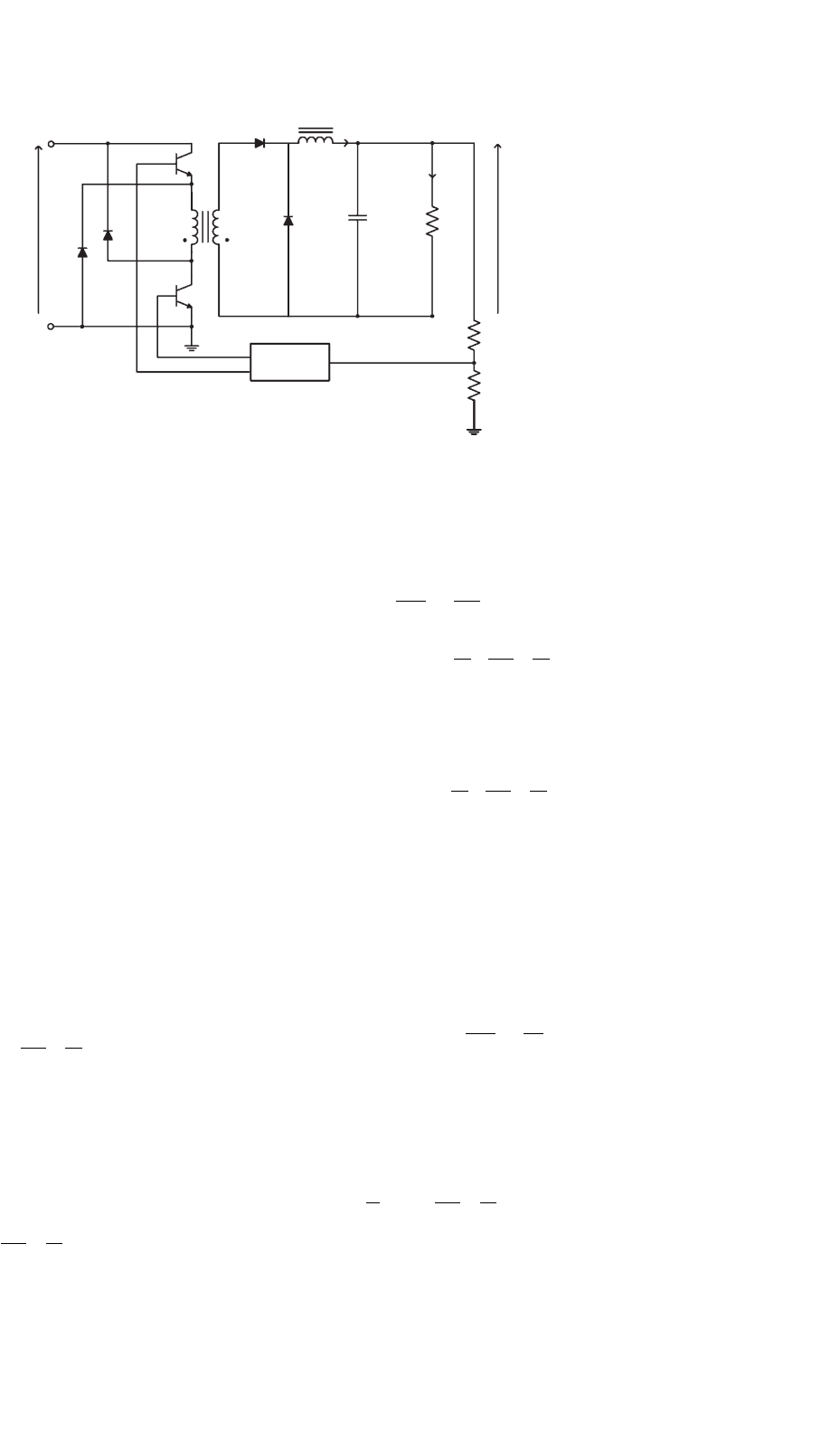
23 Power Supplies 611
Control
N
s
D
R4
C
F
Q
2
Q
1
N
p
R
L
V
o
V
i
R
1
R
2
L
1
I
L1
I
L
D
R3
D
R2D
R1
FIGURE 23.25 Double-ended forward regulator.
This square-wave is either stepped down or up by the iso-
lation transformer and then rectified by the diodes D
R1
and
D
R2
. Subsequently, the rectified voltage is filtered to produce
the output voltage V
o
.
Under steady state condition, the operation of the regula-
tor can be explained as follows. When Q
1
is on and Q
2
off,
D
R1
conducts and D
R2
is reverse-biased. The primary volt-
age V
p
is V
i
/
2. The primary current I
p
starts to build up and
stores energy in the primary winding. This energy is forward-
transferred to the secondary and onto the L
1
C filter and the
load R
L
, through the rectifier diode D
R1
. During the time inter-
val , when both Q
1
and Q
2
are off, D
R1
and D
R2
are forced
to conduct to carry the magnetizing current that resulted in
the interval during which Q
1
is turned on. The inductor cur-
rent I
L1
in this interval is equal to the sum of the currents in
D
R1
and D
R2
. This interval terminates at half of the switching
period T , when Q
2
is turned on. When Q
2
is on and Q
1
off,
D
R1
is reverse-biased and D
R2
conducts. The primary voltage
V
p
is now −V
i
/
2. The circuit operates in a likewise manner as
during the first half cycle.
With Q
1
on, the voltage across the secondary winding is
V
s1
=
N
s1
N
p
V
i
2
(23.60)
Neglecting diode voltage drops and losses, the voltage across
the output inductor is then given by
V
L1
=
N
s1
N
p
V
i
2
−V
o
(23.61)
In this interval, the inductor current I
L1
increases linearly at
the rate of
dI
L1
dt
=
V
L1
L
1
=
1
L
1
N
s1
N
p
V
i
2
−V
o
(23.62)
At the end of Q
1
on-time, I
L1
reaches a value which is given
by
I
L1(pk)
= I
L1
(0) +
1
L
1
N
s1
N
p
V
i
2
−V
o
DT (23.63)
During the interval , I
L1
is equal to the sum of the recti-
fier diode currents. Assuming the two secondary windings are
identical, I
L1
is given by
I
L1
= 2I
DR1
= 2I
DR2
(23.64)
This current decreases linearly at the rate of
dI
L1
dt
=
V
o
L
1
(23.65)
The next half cycle repeats with Q
2
on and for the interval .
The output voltage can be found from the time integral of
the inductor voltage over a time equal to T. Thus, we have
V
o
= 2 ×
1
T
DT
0
N
s1
N
p
V
i
2
−V
o
dt +
T
/
2
+DT
T
/
2
−V
o
dt
(23.66)
